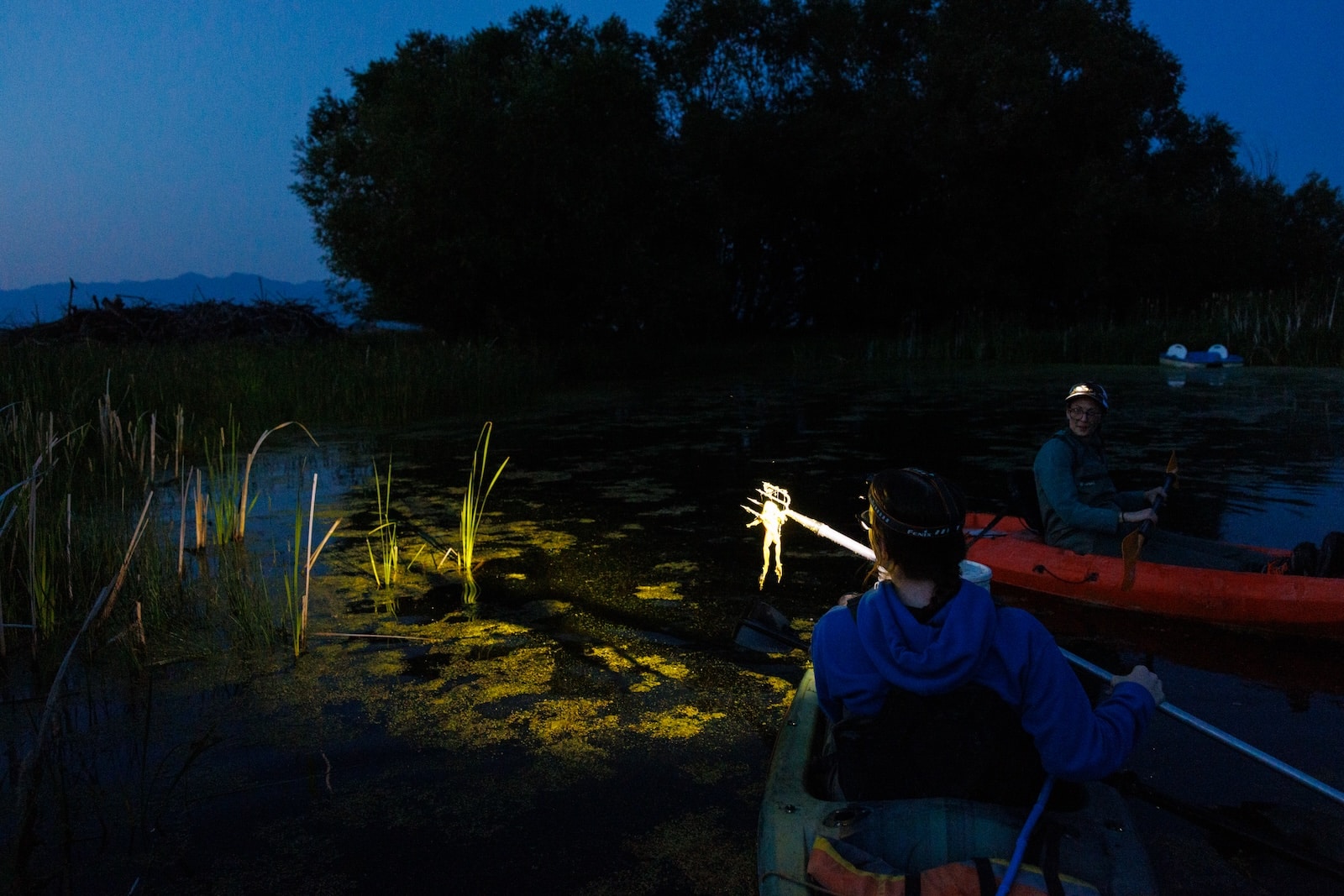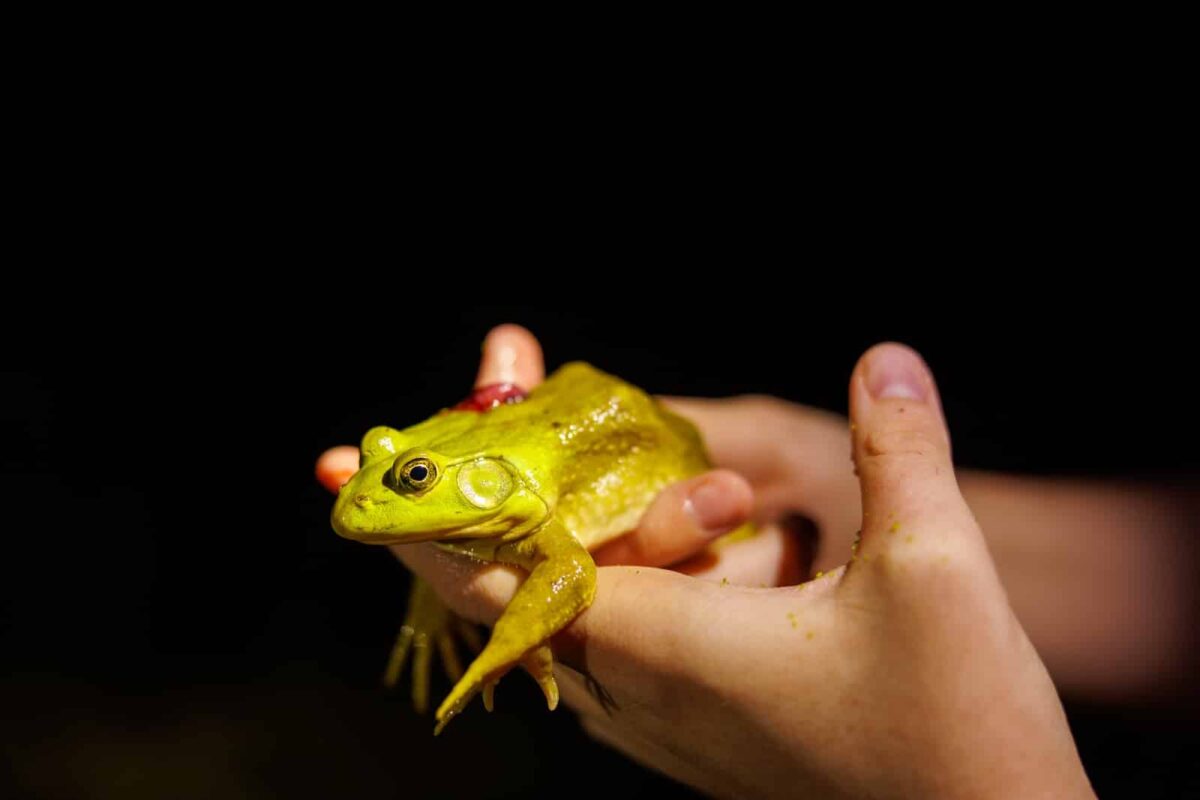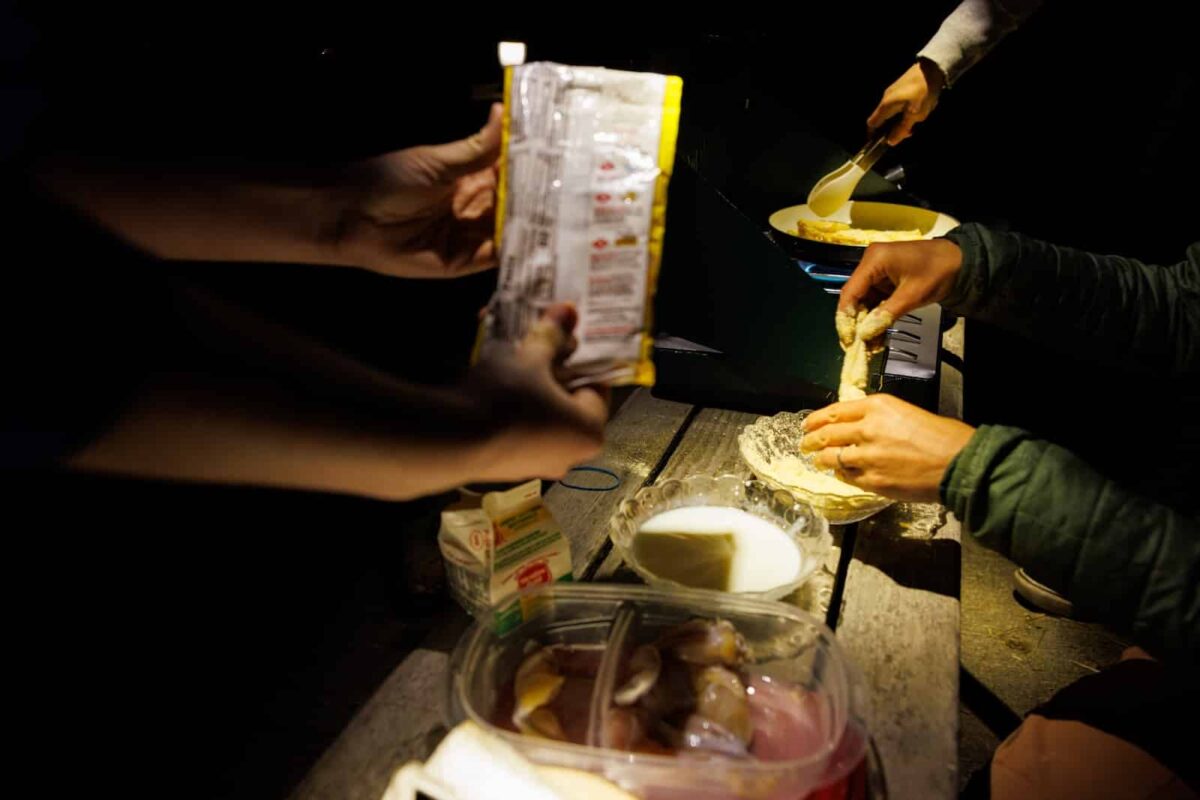
On Patrol with CSKT’s Nocturnal Bullfrog Hunters
The Confederated Salish and Kootenai Tribes have removed more than 10,000 invasive American bullfrogs from the Flathead Reservation
The moon is high over the Mission Valley as Briana Rentschler’s kayak slips silently into a marshy wetland near the Ninepipe Reservoir — and then, a deep croak cuts through the quiet like a foghorn.
“You can’t let them know you’re coming,” says Rentschler, a 22-year-old Montana Conservation Corps staffer wearing a headlamp and waders. “They’re learning fast, so we are adapting fast.”
She glides through the water with a long trident-like “gig” balancing across the nose of the boat. Suddenly Rentschler locks in on the prize — the whites of its eyes barely peeking above the swirling, green algae. She slowly paddles toward the target, careful not to point her headlamp directly at it. Finding balance on the water, she picks up her weapon, lightly replacing it with her paddle, and steadily cocks back her elbow.
In one swift swoop, she spears the burly specimen and plucks it out of the pond. A wide smile spreads across her face as she turns to show the trophy — the American bullfrog, an invasive species with big consequences for conservation efforts here on the Flathead Reservation.
On this summer night, Rentschler and fellow “bullfrogger” Amanda Emmel, hired by the Confederated Salish and Kootenai Tribes, would remove four adult bullfrogs and two egg masses from the wetland. Those two egg masses alone equate to tens of thousands of would-be tadpoles. By summer’s end, the effort would net more than 2,000 individuals and 19 egg masses.
Beyond reproducing so prolifically, American bullfrogs eat just about anything and adapt to almost any freshwater habitat, and as they spread they box out native species that to the tribes are both culturally and ecologically significant.
“They’re a trifecta as far as invasive species go,” says Cara Thompson, a wildlife biologist who leads CSKT’s bullfrog management project. “Once they’re established, they’re near impossible to get rid of.”
By moonlighting as amphibian assassins, Thompson and her hired guns are keeping these biological bullies in check, removing more than 10,000 American bullfrogs from ponds and wetlands across the Flathead Reservation since launching the effort in 2021.
The CSKT bullfrog management project is a collaboration with Montana Fish, Wildlife & Parks, employing two to four “bullfroggers” from the Missoula-based Montana Conservation Corps every year. During these swamp safaris, crews employ a mix of techniques. Gigging (or spearing) remains most effective for adults. Traps can be deployed in deeper waters, though they require careful checking. And this past summer, a pellet gun — called the “bullfrog berserker” — was added to the arsenal to snipe clever bullfrogs that stay just out of gigging range.


Scientists have long ranked Lithobates catesbeianus as one of the world’s worst invasive species. It’s native to eastern North America and considered non-native in much of the American West. According to Stephanie Gillin, a tribal wildlife biologist and community education coordinator, the American bullfrog was first discovered in the Flathead River Basin sometime in the 1960s. Details surrounding its introduction are unknown, but theories include a liberated pet and a 4th of July race runaway.
The average American bullfrog measures four to six inches long. Some of the larger ones can grow to the size of a small house cat. The brutes easily outcompete the much smaller amphibians native to western Montana, with their indiscriminate diet including tadpoles, small fish, other frogs, snakes, even juvenile turtles and birds. On the Flathead Reservation, one bullfrog captured in 2003 was concealing baby birds in its stomach. That individual is now preserved in a jar on a shelf in the CSKT wildlife office hallway.
The Mission Valley’s prairie pothole landscape is dimpled with wetlands that are home to a variety of aquatic and avian species, pools increasingly inviting to bullfrogs as western Montana’s climate warms. Their proliferation, as Phil Matson of the Flathead Lake Biological Station explains, is likely also aided by the 1,300 miles of agricultural canals crisscrossing the valley that make up the century-old Flathead Indian Irrigation Project.
“Once we started irrigating that valley with a system of canals, the bullfrog fit in quite nicely,” Matson says.

The stakes extend beyond the valley to the larger Crown of the Continent ecosystem. Matson says one of the top priorities is preventing bullfrogs from migrating to the north, warning that reaching the Flathead River where it enters Flathead Lake could threaten endangered species like the bull trout. Containment begins, he says, with keeping bullfrogs out of the Ninepipe Reservoir and Kicking Horse Reservoir, two of the larger water bodies in the reservation’s web of irrigation canals.
But much damage has already been done to native species — especially the northern leopard frog, which the bullfrog both eats and outcompetes. By the 1980s, the northern leopard frog had all but disappeared from the Mission Valley and the rest of its native Montana range west of the continental divide.
“Once you wipe out a native species, they’re slow to come back,” Matson says. “Prevention is key, but now that bullfrogs have been introduced here in the Mission, a blanket strategy between land managers and private landowners will be critical for natives to hang on.”
The Confederated Salish and Kootenai Tribes have been reintroducing northern leopard frogs since the early 1990s, and now the reservation is home to the only established populations in western Montana.
The bullfrog control program appears to be working. According to Thompson, bullfrogs were detected in about 25 ponds across 10 to 12 distinct areas of the valley this year, similar numbers to last year. She says this likely reflects successful efforts to prevent “exploratory” frogs from populating new sites. With only one new infestation found, there’s hope that the native leopard frog could again outnumber its domineering neighbor.
Thompson stresses that public awareness is paramount. “Bucket biologists” — people who introduce species into new areas, often for sport — can inflict irreversible damage on fragile ecosystems.
“Biodiversity is one of those things that some people inherently value,” she says. “But it can be hard to convey the importance of it. Small things can have big changes.”

Back at the moonlit wetland, it’s around 2 a.m., the hunt is over, and Thompson, Rentschler and Emmel hop in their truck and drive five minutes down a dirt road to a wildlife viewing pullout near the Ninepipe Reservoir.
From the back of the truck, Thompson pulls out a cooler with a Ziploc bag full of skinned and frozen frog legs. She hands the bag to Emmel, who pulls out the smooth, pinkish-white legs, dunks them in buttermilk and then dusts each of them in creole breading before dropping them into a pan crackling with oil. After setting out several dipping sauces, Thompson expertly times each piece, turning them over with tongs, the meat sizzling under the light of their headlamps.
The tired crew crowds close to the hot skillet. The first batch doesn’t last long. Rentschler goes back for seconds, declaring that a little lemon squeeze is all it needs.
It isn’t a nightly ritual, but when the timing is right, the spoils of the hunt make for a memorable meal. Despite my reservations, this reporter found the frog legs to be better than chicken wings, making the harsh realities of controlling this invasive species much more, well, palatable.
This story originally appeared in The Pulp, which can be found online at thepulp.org.



